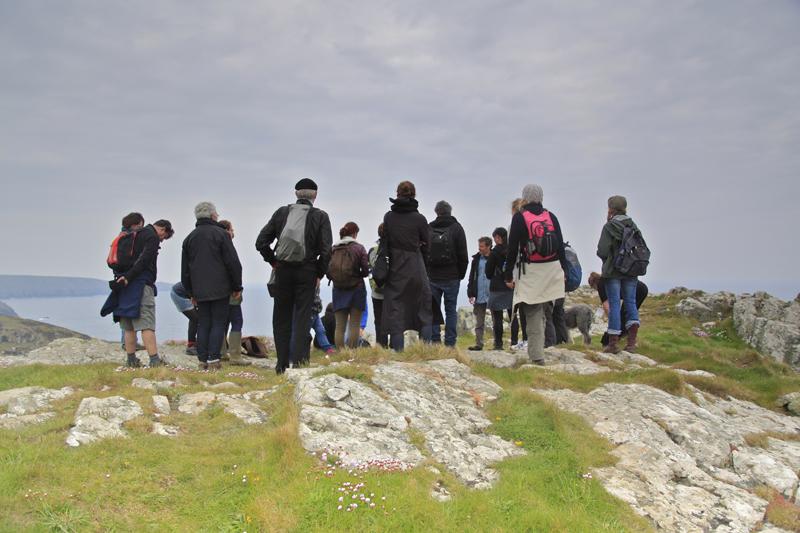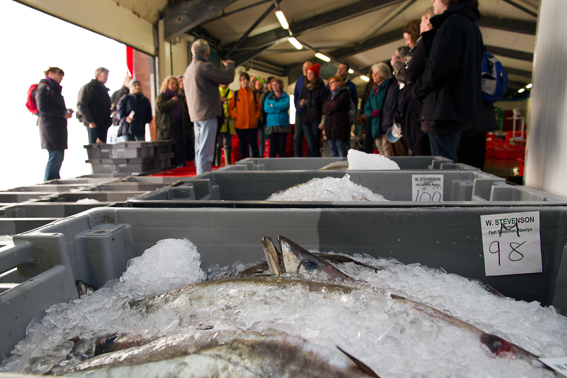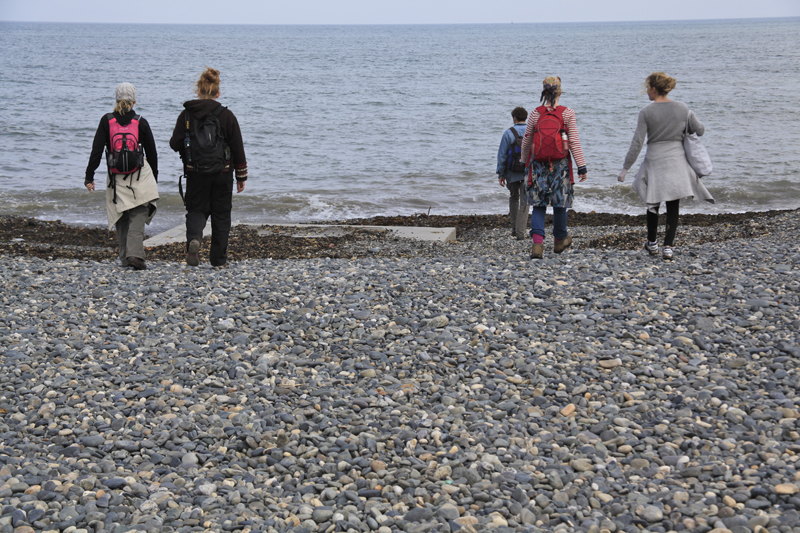theartsdesk at Land's End: The Penzance Convention | reviews, news & interviews
theartsdesk at Land's End: The Penzance Convention
theartsdesk at Land's End: The Penzance Convention
Redefining art at the very end of England

Standing in Tate St Ives with the sun gleaming on the Atlantic, you wonder who they are, all these chilled, nonchalantly now people. Through the great curved window, the sun is setting over the barren headland of the Land’s End peninsular, the landscape that inspired Barbara Hepworth, Ben Nicholson et al.
There are a few Mayfair-on-the-beach types, a couple of art world heavy hitters: Nick Serota of Tate (well, this is Tate), veteran über-dealer Anthony d’Offay. And if some of this appearance of change may be superficial – many of these people will be back in London by this time tomorrow – the overall demographic is about 30 years younger than you’d expect, and the majority really do live here.
Rather than sit in a room talking, participants went on field trips into Land’s End - down tin mines, along quaysides
For decades Cornwall lived off its somewhat inflated reputation as a mid-century Modernist Mecca – with steadily diminishing returns. Only recently a sculptor of my acquaintance was advised by his dealer not to tell people he lived in Cornwall for fear of being written off as sub-modernist retro-tat. But now a new spirit is abroad that has nothing to do with celebrating or even deconstructing the achievements of Hepworth, Nicholson, Heron and co, and by and large it avoids St Ives.
It’s got something to do with the expansion of the once sleepy Falmouth College of Art into the go-ahead University College Falmouth; and if that growth has more to do with corporate empire building than anything that’s organically happening here, these things have a way of rippling outwards. Then there’s the fact that a critical mass of artists whose interests have little to do with established notions of "Cornish art" have come to live here over the past few years.
 Penzance, Land’s End’s scruffy but subtly funky metropolis, played host to an event that provided a focus and a forum for this spirit; an event that was part academic conference, part performative work of art in its own right: the Penzance Convention. Basing itself in the Exchange, the recently created gallery in the town’s old telephone exchange – a venue generally reviled by the Cornish old guard – the Convention took as its theme "extraction", both in relation to Cornwall’s traditional industries – mining, farming and fishing (pictured above right, Newlyn Fish Auction) – and to the "processes by which artists draw meaning from history and site". Rather than sit in a room talking, participants went on "field trips" into Land’s End and the surrounding area: down one of the tin mines, whose chimneys are iconic symbols of this part of Cornwall; along the quaysides of Newlyn, still the biggest fishing port in England; on a hike across the peninsular (pictured overleaf, Walk from Gurnard’s Head to Penzance); and into the artist’s mind, in an attempt to extract creativity.
Penzance, Land’s End’s scruffy but subtly funky metropolis, played host to an event that provided a focus and a forum for this spirit; an event that was part academic conference, part performative work of art in its own right: the Penzance Convention. Basing itself in the Exchange, the recently created gallery in the town’s old telephone exchange – a venue generally reviled by the Cornish old guard – the Convention took as its theme "extraction", both in relation to Cornwall’s traditional industries – mining, farming and fishing (pictured above right, Newlyn Fish Auction) – and to the "processes by which artists draw meaning from history and site". Rather than sit in a room talking, participants went on "field trips" into Land’s End and the surrounding area: down one of the tin mines, whose chimneys are iconic symbols of this part of Cornwall; along the quaysides of Newlyn, still the biggest fishing port in England; on a hike across the peninsular (pictured overleaf, Walk from Gurnard’s Head to Penzance); and into the artist’s mind, in an attempt to extract creativity.
With the participants reconvening in the Exchange on the Saturday morning, geologist Robin Shail, of the Camborne School of Mines, began things in punchy pop-science style, reporting back on a field trip into South Crofty, Cornwall’s last working tin mine, which closed in 1998. Did we realise that simply by using a mobile phone we were adding to the despoliation of the earth? Or that the granite we were on is still rich in mineral resources? It is the economics of getting them out that’s at issue. If the viability of reactivating the tin industry is being tested at South Crofty, a free new visitor attraction, Heartlands, has just opened in Robinson’s Shaft, the mine immediately next door. Billing itself as "19 acres of cultural candy", its forthcoming attraction is a bouncy-castle version of Stonehenge. Sound like a rip-off of Jeremy Deller’s Sacrilege? It is Jeremy Deller’s Sacrilege. Nobody in the room wanted to wish this much-needed employment-creator ill.
 In contrast, the farming field trip led by art-research duo Fieldclub appeared whimsical to the point of opacity. Artist Paul Chaney and researcher Kenna Hernley investigate "hypothetical and post-apocalyptic models of farm production" from a four-acre site "somewhere in Cornwall". Their presentation "The Story of NPK" looked at the way plants "steal energy from the sun to facilitate higher life". While I was left unsure as to the scientific validity of their experiments – or if they even exist – the places visited on their field trip were real enough, from an neolithic farming enclosure near Zennor to an industrial daffodil farm – the largest in Europe – where the mostly Eastern European workforce receive the health and safety training necessary to putting plastic bands round the 160,000,000 bunches produced each year. Now that is an image of Cornwall I very much recognise.
In contrast, the farming field trip led by art-research duo Fieldclub appeared whimsical to the point of opacity. Artist Paul Chaney and researcher Kenna Hernley investigate "hypothetical and post-apocalyptic models of farm production" from a four-acre site "somewhere in Cornwall". Their presentation "The Story of NPK" looked at the way plants "steal energy from the sun to facilitate higher life". While I was left unsure as to the scientific validity of their experiments – or if they even exist – the places visited on their field trip were real enough, from an neolithic farming enclosure near Zennor to an industrial daffodil farm – the largest in Europe – where the mostly Eastern European workforce receive the health and safety training necessary to putting plastic bands round the 160,000,000 bunches produced each year. Now that is an image of Cornwall I very much recognise.
It was an event that was about possibilities, cross-currents and meetings rather than solutions
In a session on "Extraction and its Complications", Falmouth-based philosopher Robin Mackay looked at the way images and experiences are extracted from Cornwall’s economically depressed landscape by and for the tourist industry. He speculated that public art commissions extract from the areas they take place in, and it’s questionable how much they put back – a worthwhile point that could have been taken further.
Marxist philosopher Esther Leslie, meanwhile, considered the ways science extracts colour from coal in the form of dyes, and explored the idea of mines as places for dreaming. Intriguing as this was, it removed the event to the realm of observation. Artist John Gerrard returned it to the area of action with his mind-boggling digital recreations of dust storms in parts of America that were desertified in the 1930s, and are being further depleted by robotised industrial farming.
The Penzance Convention felt like a moment on the road somewhere. If the notion of extraction never seemed to quite cohere, it was an event that was about possibilities, cross-currents and meetings rather than solutions. Yet perhaps the framing of extraction was a little too narrow. References to tourism were tangential. There was no mention of other forms of post-modern extraction such as second-home ownership or DJ culture on Redruth housing estates. And there was absolutely zero on the extraction from the legacies of Bernard Leach, Barbara Hepworth and Ben Nicholson that is such a feature of the area. But then that would have been far too close to everything this event was trying to get away from.
- Further information on The Penzance Convention.
Explore topics
Share this article
Add comment
The future of Arts Journalism
You can stop theartsdesk.com closing!
We urgently need financing to survive. Our fundraising drive has thus far raised £49,000 but we need to reach £100,000 or we will be forced to close. Please contribute here: https://gofund.me/c3f6033d
And if you can forward this information to anyone who might assist, we’d be grateful.

Subscribe to theartsdesk.com
Thank you for continuing to read our work on theartsdesk.com. For unlimited access to every article in its entirety, including our archive of more than 15,000 pieces, we're asking for £5 per month or £40 per year. We feel it's a very good deal, and hope you do too.
To take a subscription now simply click here.
And if you're looking for that extra gift for a friend or family member, why not treat them to a theartsdesk.com gift subscription?
more Visual arts
 'We are bowled over!' Thank you for your messages of love and support
Much-appreciated words of commendation from readers and the cultural community
'We are bowled over!' Thank you for your messages of love and support
Much-appreciated words of commendation from readers and the cultural community
 Folkestone Triennial 2025 - landscape, seascape, art lovers' escape
Locally rooted festival brings home many but not all global concerns
Folkestone Triennial 2025 - landscape, seascape, art lovers' escape
Locally rooted festival brings home many but not all global concerns
 Sir Brian Clarke (1953-2025) - a personal tribute
Remembering an artist with a gift for the transcendent
Sir Brian Clarke (1953-2025) - a personal tribute
Remembering an artist with a gift for the transcendent
 Emily Kam Kngwarray, Tate Modern review - glimpses of another world
Pictures that are an affirmation of belonging
Emily Kam Kngwarray, Tate Modern review - glimpses of another world
Pictures that are an affirmation of belonging
 Kiefer / Van Gogh, Royal Academy review - a pairing of opposites
Small scale intensity meets large scale melodrama
Kiefer / Van Gogh, Royal Academy review - a pairing of opposites
Small scale intensity meets large scale melodrama
 Jenny Saville: The Anatomy of Painting, National Portrait Gallery review - a protégé losing her way
A brilliant painter in search of a worthwhile subject
Jenny Saville: The Anatomy of Painting, National Portrait Gallery review - a protégé losing her way
A brilliant painter in search of a worthwhile subject
 Abstract Erotic, Courtauld Gallery review - sculpture that is sensuous, funny and subversive
Testing the boundaries of good taste, and winning
Abstract Erotic, Courtauld Gallery review - sculpture that is sensuous, funny and subversive
Testing the boundaries of good taste, and winning
 Edward Burra, Tate Britain review - watercolour made mainstream
Social satire with a nasty bite
Edward Burra, Tate Britain review - watercolour made mainstream
Social satire with a nasty bite
 Ithell Colquhoun, Tate Britain review - revelations of a weird and wonderful world
Emanations from the unconscious
Ithell Colquhoun, Tate Britain review - revelations of a weird and wonderful world
Emanations from the unconscious
 Rachel Jones: Gated Canyons, Dulwich Picture Gallery review - teeth with a real bite
Mouths have never looked so good
Rachel Jones: Gated Canyons, Dulwich Picture Gallery review - teeth with a real bite
Mouths have never looked so good
 Yoshitomo Nara, Hayward Gallery review - sickeningly cute kids
How to make millions out of kitsch
Yoshitomo Nara, Hayward Gallery review - sickeningly cute kids
How to make millions out of kitsch
 Hamad Butt: Apprehensions, Whitechapel Gallery review - cool, calm and potentially lethal
The YBA who didn’t have time to become a household name
Hamad Butt: Apprehensions, Whitechapel Gallery review - cool, calm and potentially lethal
The YBA who didn’t have time to become a household name

Comments
This article is mean spirited
I think thats a great report
A good report with some nice